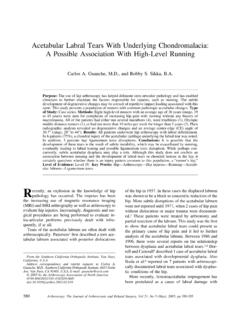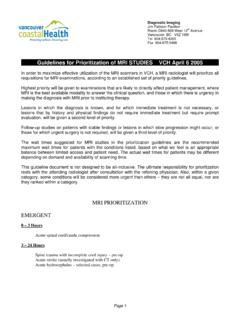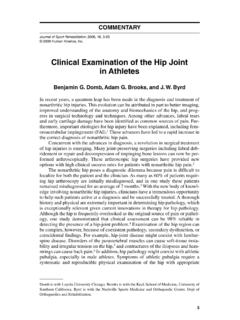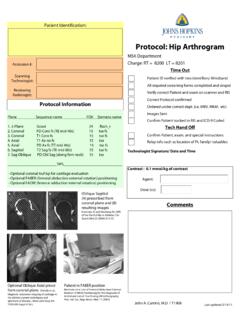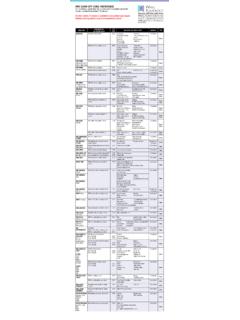Transcription of Instructional Course Lecture Differentiating Hip …
1 Instructional Course Lecture Differentiating Hip Pathology From Lumbar Spine Pathology: Key Points of Evaluation and Management Abstract Aaron J. Buckland, MBBS, The diagnosis and treatment of patients who have both hip and lumbar FRACS spine pathologies may be a challenge because overlapping Ryan Miyamoto, MD symptoms may delay a correct diagnosis and appropriate treatment. Rakesh D. Patel, MD Common complaints of patients who have both hip and lumbar spine pathologies include low back pain with associated buttock, groin, James Slover, MS, MD. thigh, and, possibly, knee pain.
2 A thorough patient history should be Afshin E. Razi, MD obtained and a complete physical examination should be performed in these patients to identify the primary source of pain. Plain and advanced imaging studies and diagnostic injections can be used to further delineate the primary pathology and guide the appropriate sequence of treatment. Both the surgeon and the patient should understand that, although one pathology is managed, the management of the other pathology may be necessary because of persistent pain. The recognition of both entities may help reduce the likelihood of misdiagnosis, and the management of both entities in the appropriate sequence may help reduce the likelihood of persistent symptoms.
3 H ip and lumbar spine patholo- gies often occur in combina- tion, which may result in substantial symptoms is clear despite coexistent hip and lumbar spine pathologies. In patients with complex hip-spine syn- Patients with both hip drome, however, no clear source of and lumbar spine pathology com- symptoms is known despite a detailed monly have low back pain (LBP) physical examination. Patients with with associated buttock, groin, complex hip-spine syndrome require From the NYU Hospital for Joint thigh, and, possibly, knee pain. The additional diagnostic tests, including Diseases, New York, NY (Dr.)
4 Buckland, diagnosis and treatment of these diagnostic injections. In patients with Dr. Slover and Dr. Razi), Fair Oaks patients may be a challenge because secondary hip-spine syndrome, both Orthopaedics, Fairfax, VA. (Dr. Miyamoto), and the Department of overlapping symptoms may delay a pathologies are interdependent, and Orthopaedic Surgery, University of correct diagnosis and, therefore, the symptoms of one region are sec- Michigan Health System, Ann Arbor, MI appropriate treatment. ondary to the pathology of the other. (Dr. Patel). Offierski and MacNab4 originally The authors reported that flexion J Am Acad Orthop Surg 2017;25: described the term hip-spine syn- contracture of the hip that results in e23-e34 drome in 1983.
5 The authors clas- compensatory hyperlordosis of the DOI: sified hip-spine syndrome as simple, lumbar spine, which causes foraminal complex, secondary, or misdiagnosed. stenosis, especially at L3-4, is an Copyright 2016 by the American Academy of Orthopaedic Surgeons. In patients with simple hip-spine example of secondary hip-spine syn- syndrome, the primary source of drome. Similarly, scoliosis that causes February 2017, Vol 25, No 2 e23. Copyright the American Academy of Orthopaedic Surgeons. Unauthorized reproduction of this article is prohibited. Differentiating Hip Pathology From Lumbar Spine Pathology: Key Points of Evaluation and Management pelvic obliquity and acetabular tilt putting on shoes or getting in and evaluation.
6 Surgeons should observe may result in uncovering of the fem- out of a car are associated with hip a patient's posture, muscle atrophy, oral head. In patients with mis- pathology. A burning or electric previous surgical scars, limb-length diagnosed hip-spine syndrome, the character to pain may be more sug- discrepancy, pelvic obliquity, and primary source of pain is incorrectly gestive of lumbar spine pathology, lower limb and spinal alignment diagnosed, which results in inappro- especially if accompanied by a nerve- (coronal, sagittal, and rotational). If priate, expensive treatment.
7 Root signature or associated numb- a limb-length discrepancy exists, Unsurprisingly, hip and lumbar ness or weakness. The ability of a blocks should be placed under the spine pathologies may mimic one patient to ambulate with a forward patient's short leg to obliterate pelvic another. Several studies have reported posture, which is known as the obliquity before observing spinal on the source of referred hip pain, shopping cart sign, or improvement alignment. The forward bend test which includes all lumbar nerve roots in pain in a sitting position may should be performed to assess spinal via the sciatic, obturator, and femoral indicate lumbar stenosis.
8 The rotational deformity; in a patient's ,6 Surgeons should under- inability of a patient to lie on his or attempt to achieve extension, pain stand how to perform a comprehen- her side is likely caused by trochan- may indicate lumbar stenosis or sive evaluation of and appropriately teric bursitis rather than lumbar spinal instability. Palpation for areas treat patients with potential hip and radiculopathy or intra-articular hip of tenderness over the greater tro- lumbar spine pathologies. pathology. Clicking, snapping, or chanter, sacroiliac joints, groin, pain with movement of the hip likely buttock, and lumbar spine and evi- indicates intra-articular hip pathol- dence of step-off between spinous History ogy.
9 Some patients may describe hip processes may be clues to the more pain in which he or she grasps the likely pathology. An observation of a A thorough patient history is crucial lateral aspect of the hip with his or patient's gait may help surgeons to differentiate hip pathology from her thumb and index finger in the lumbar spine pathology. A thorough assess for antalgic gait or the pres- groin (C-sign). Changes in posture patient history begins with an ence of an abductor lurch. Walking may highlight potential psoas assessment of the temporal onset, on the heels and toes may indicate pathology if pain is felt in the groin duration, severity, location, and subtle weakness as a result of L4.
10 And thigh or spinal instability if pain character of the pain and the ante- through S1 nerve involvement. is felt in the lower back. A history of cedent trauma. Surgeons must deter- The Trendelenburg test should be startup groin pain (ie, pain that mine whether a patient has pain with performed. Although a positive usually improves after 5 to 10 steps activity, at rest, or both. Pain at night Trendelenburg test has been re- and then gradually returns) may and the presence or absence of pain- ported to indicate hip pathology, the indicate a loose total hip arthro- free intervals may indicate a tumor or plasty (THA) component.


